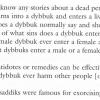2: Questionnaire excerpt, S. Ansky’s "Jewish Ethnographic Program," 1912, translation from Yiddish.
In 1912 Ansky set out on a two-year expedition to collect information about stories, folktales, songs, and superstitions from Jews in communities across Eastern Europe. This is an excerpt from the questionnaire that Ansky and his colleagues were planning to use to interview their subjects, before their expedition was cut short by the onset of World War I. It offers rare insight into the lore of Eastern European Jews prior to the war. Many of the questions concern the figure of the dybbuk, a departed, tormented spirit that, according to Eastern European Jewish legend, returns to earth to possess the body of a living person. The word "dybbuk" comes from the Hebrew ledavek, to cling.
Suggested activity: Ask students if they had ever heard the term “dybbuk” before and what they know about it. Discuss the concept of a dybbuk and its etymology.
Next, divide the students into small groups and ask each group to choose five questions that interest them the most. After each group briefly researches any unfamiliar terms in the questions, ask groups to imagine how respondents might have answered these questions in 1913. What do these questions tell us about Jewish life in Eastern Europe during this period? About Jewish communities? About Jewish superstition and belief? How might asking these questions have been useful to Ansk-i as a playwright seeking material for a drama?
S. Ansky, “From 'The Ethnographic Expedition': Questionnaire,” in The Dybbuk and the Yiddish Imagination: A Haunted Reader, ed. and trans. Joachim Neugroschel (Syracuse: Syracuse University Press, 2000), 56.

